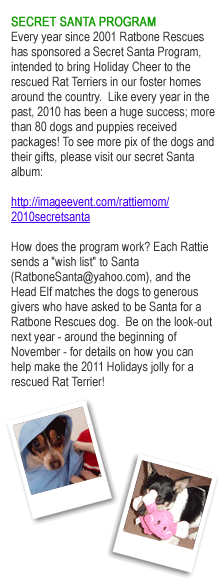

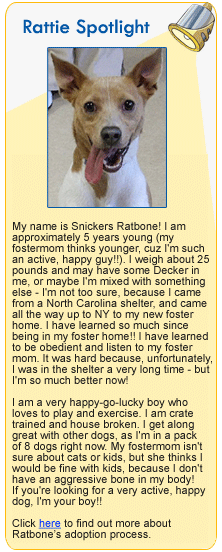
| As promised, in the February edition of The Ratbone Barker you can send a personal love note, message or wish to your favorite Ratty, loved one or anyone you want. To have your heart wish appear on the Valentine edition of The Barker, all you need to do is make a donation to Ratbone Rescues and submit the information for your heart.
The entry in the description box should appear like this: Barker Hearts - 1. blue, I luv Ratbone Rescues; 2. green, Ducky Loves Mom. Your message limits are 4 lines, with up to 8 characters (spaces count) in the first line, 11 in the second, 9 in the third and 6 in the 4th. In some cases this number may be too high, depending on the letters used. We will modify your text only to the extent necessary to fit onto the heart. You may also pick the color of the heart for your message. Choices are pastel yellow, green, orange, pink, lavender, blue and white. If you send out a wish to someone, be sure they are subscribed to the newsletter before February 12, so they will receive our Valentine issue. Subscribing is easy, just go here: http://www.ratbonerescues.com/Barker.php
|
 |
||||||
 |
|
 |
||||
 |
||||||

Michelle Culbertson has been volunteering for Ratbone since 2006. She's fostered over 75 dogs in that short time because she's been lucky (and brave) enough to foster litters of puppies. She’s also helped with applications, fostering, transports, home visits, and adoption certificates. In 2008 she became Ratbone’s Application Coordinator. After adopting Gabriel Ratbone, she wanted to do more because she knew that Ratbone was “all about the dogs.” She also developed an immediate fondness for the breed.
Michelle's first foster was Bonnie, a pregnant female. One of the six puppies, Weezie, turned out to have torn ureters and Michelle assumed that with her being in rescue, she would be put down. Not so, Ratbone got Weezie to a surgeon who fixed her and was adopted. Michelle remains impressed that Ratbone is about the dogs and not about the money.
 When asked about difficulty letting go of a foster, Michelle confided that Skippy was the hardest foster she ever had to let go. He was surrendered after 7 years with his family, because they were moving. Michelle had him for such a long time that when he left she couldn't quit crying and worrying that he would feel abandoned again. Skippy's adopter became a volunteer with transports.
When asked about difficulty letting go of a foster, Michelle confided that Skippy was the hardest foster she ever had to let go. He was surrendered after 7 years with his family, because they were moving. Michelle had him for such a long time that when he left she couldn't quit crying and worrying that he would feel abandoned again. Skippy's adopter became a volunteer with transports.
As a child, Michelle never had a dog of her own so she would bring home strays that she would hide on the back porch and sneak food for. When she finally got her first dog, it was a rescue. At age six, her beloved black lab was diagnosed with lymphoma died within a year. These days Michelle, her childhood-sweetheart/husband and their two kids live in upstate New York. It's definitely a good marital match (from Ratbone's viewpoint) because her hubby is a truck driver and has transported dogs on his 18 wheeler. Michelle could probably give some other reasons but that's for a different story.

Doggie Dining
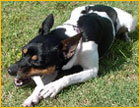 It seems in these modern times more of our owners are finding ways to spend time and enjoy experiences with us that they couldn't even image a decade ago. One of these experiences is dining with us doggies!
It seems in these modern times more of our owners are finding ways to spend time and enjoy experiences with us that they couldn't even image a decade ago. One of these experiences is dining with us doggies!
There are two different types of environments that welcome canines. One is the human restaurants that allows dogs to accompany their owners but doesn't offer us a menu (say what?). Then there are the even more progressive establishments that include wholesome food choices for dogs along with their human selections. Remember, if you are lucky enough to be invited to dinner, be on your best behavior so that you, and the rest of us, remain welcome in the future.
Here's a few guidelines to help ensure that everyone has a pleasant experience:
- Take your human for a walk before going to the restaurant. This will give you a chance to “take care of business” as well as expend any extra energy so that you will be calm and well behaved.
- Remember that not all humans are on-board with canine company at the dinner table. Don't go up to strangers, go directly to your human’s table, and sit quietly. Nothing will make you and your human more unwelcome than disturbing others.
- Be sure to pack a favorite chew toy because you are likely to get bored. Suggest to your humans that they take you for quick meals and not long meals where they might linger for a couple of hours.
- If you are in a human menu only establishment, be sure your human brings a bowl and bottle of water for you.
- Finally, be sure to help your human calculate a generous tip so that you will leave a good impression and be welcome back in the future!
Bone-appitite!
Daisey



Looking forward to 2011!
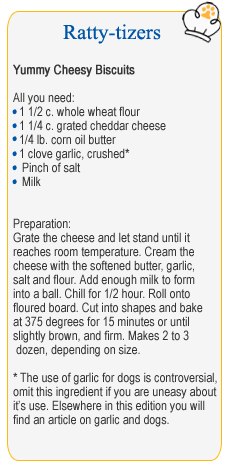

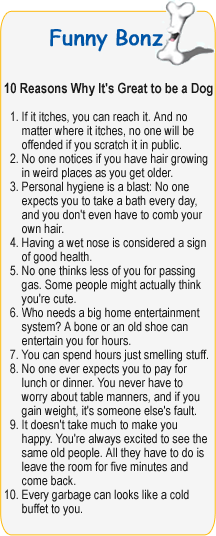
 Volunteer - Click here
Volunteer - Click here
 About our adoption process
About our adoption process
 Visit RatboneRescues.com
Visit RatboneRescues.com

*Disclaimer: The Ratbone Barker editor acknowledges there are different points of view on this subject and whether or not to give garlic products to your dog remains an individual decision.
GARLIC AND YOUR DOG. Good or Bad? Garlic has a long history as a medicinal plant in holistic medicine, for people and pets as well. However, recently, the safety of garlic for dogs (and cats) has come under close scrutiny due to its properties as a member of the Alliums genus, a branch of the lily family, along with onions and shallots. A compound found in onions and to a lesser degree in garlic, can cause oxidative damage to red blood cells. If a dog continues to consume the herb, can give the dog hemolytic anemia, leaving the dog with a low red blood cell count and possibly resulting in death.
So, is garlic dangerous for dogs? Not necessarily! The key to safely feeding garlic to your dogs appears to be the amount and frequency of use. For a dog to develop hemolytic anemia, he would have to eat over 0.5% of his body weight in onions to even begin the oxidative process. This means a healthy 60-pound dog would have to eat nearly 1/3 pound of onion, or several cloves of garlic. Since bone marrow in a healthy dog constantly produces red blood cells, a dog would most likely have to ingest this amount of onion or garlic repeatedly, over time, to cause permanent harm. Note, if your pet has a pre-existing anemic condition or is scheduled for surgery, you should not give it garlic. Puppies under eight weeks of age should NOT be given garlic either as they do not begin making new blood cells until after 6-8 weeks of age. If you are still unsure about using garlic, do more research on the subject of “garlic and dogs”, or, to err on the side of caution, omit garlic from the recipe.

Can't Play Outdoors?
Can't or don't want to take your dog outside? Try these indoor games with your dog.
Submitted by Terry Nickerson, Bark Buster Behavior Therapist and Trainer
All dogs need exercise, even when there is inclement weather or you just don't feel like going outside. Try playing some of these indoor games with your dog to keep him healthy and happy. In addition, playing with your dog, like training him, enhances the bond you share and helps him keep his focus on you!
You can change these games depending on how your dog is best motivated: praise/belly rubs, favorite toys, items to fetch, or treats. If you do use treats, one way to keep your dog from gaining weight from too many snacks is to use some of his mealtime kibble to play the games. As with any activity, keep each session short and fun! It’s better to end the game before your dog gets bored or overly excited.
WHERE'S THE TREAT?
Start with 3 or 4 buckets (old cups or margarine tubs would work too). Show your dog that you have a treat or a favorite small toy. Put your dog in a SIT/STAY or DOWN/STAY about 10 feet away, then make sure he can see you as you place his prize under one of the buckets. Then say WHERE'S THE TREAT? and encourage him to smell the buckets—give him lots of praise when he paws, sits beside, or barks next to the correct bucket, and then lift it up so he can claim his reward. You can up the difficulty level by changing the position of the buckets after you place the treat or pretending to put treats under multiple buckets.
NAME THAT TOY
Gather a group of toys that are noticeably different (for example, a stuffed duck, pig and shark). Hold a toy up for your dog to sniff and see, get him excited, and toss it, saying WHERE'S YOUR SHARK? When he comes back with it, give him lots of praise, then do the same with the pig, then with the duck, etc. Repeat again and again, and be consistent with your naming. Once he has mastered a few names, set out multiple toys and tell him which to get.
FIND IT!
Put your dog in a SIT/STAY. Show your dog a toy or treat and put it on the floor so the dog can see it. Say FIND IT! Naturally, your dog will enthusiastically—and hopefully, easily—find the toy or treat. Make the next prize a bit more difficult to locate, say, behind a chair. Continue to vary treat placement, or, for a real challenge, set up a roomful of hidden delights in advance. Watch your dog as he searches, and tap your foot and give an OOH or gasp to get him excited about the ones he’s missed.
Most of all – have fun! Not only are games fun and mind challenging for your dog, you will be building a better bond with your dog! Be sure to come back next month for even more fun games you can play with your dog.

As a state coordinator, foster parent and proud Ratbone member I often look around my house at the different dogs that I have had the pleasure to grace my home with. Each one is an individual personality, with an individual story to tell, more often than not an unhappy one. Fostering brings me great joy and joy to the little ones that I am privileged to keep and nurture back to stable loving dogs.
One such dog was a 7 month old puppy I named Caroline, who came from a horrendous puppy mill situation. I believe that before I received her she had seldom been touched by a human hand. She would cower in fear and try to bite her way out of any contact situation with people. She has been with me almost two months now and has made great strides towards becoming a puppy again.
 The first month here she was terrified. I couldn't turn her loose with out a halter and leash on because she would run for the fence and try to escape. I walked her several times a day, getting her used to a leash. During the first month she refused to eat in sight of me or the other dogs so I had to crate her and put a towel over the front so she would feel secure enough to eat. Her feet had never felt grass and she didn’t know what the inside of a house was.
The first month here she was terrified. I couldn't turn her loose with out a halter and leash on because she would run for the fence and try to escape. I walked her several times a day, getting her used to a leash. During the first month she refused to eat in sight of me or the other dogs so I had to crate her and put a towel over the front so she would feel secure enough to eat. Her feet had never felt grass and she didn’t know what the inside of a house was.
The first few weeks, Caroline hid under the couch cushions and if she caught you looking directly at her she would run and hide. In the second month there has been noticeable improvement, she has started playing with the other dogs. She has started eating with the pack and running loose in the fenced yard without trying to escape. She has even wagged her tail a time or two on seeing me.
Caroline has made great strides in the short time she has been with me and it makes my heart happy to see such a terrified puppy slowly learning to be a trusting companion. Very recently she has even come within reach and given me a quick kiss on the hand before running back to watch me. She has a long way to go yet, but I truly believe with enough time and love she will become a highly adoptable girl.
This is why I am proud to be a member of Ratbone Rescues. We don't hesitate to take in the ones that really need us, the outcast that nobody else will look twice at. There is no such thing as unadoptable, in my opinion. These lost ones just need the right people to give them the second chance they deserve. This is why we need your support and donations. Without you we could not continue to help the ones like Caroline find their forever home.

Toy Review by Eddie & Daisey
Tuffy Toys has several different lines and all are not created equal. In fact, the toys are all number coded to their toughness rating. The company makes toys of all sizes and many are just too big for a Rat Terrier so we’ll review only the ones we have tested.
The Rumble Ring from the Ultimate Series is a good one for tossing and easy to hold. It has a toughness rating of 9. We also have an Odd Ball from the same line, with a rating of 8, but we find it more difficult to carry around.
We have a couple toys from the Junior Series. The Bowmerang, rated an 8, is the only Tuffy Toy we’ve known to be torn up by a Rat Terrier (not by us). The Stone Bone from this line, toughness rated 8, is a nice shape, weight, and size for alone play or fetch. While we aren’t much interested in our Flyer, we sent this to one of our online friends and they love it. Their mama says it is the only “Frisbee” that her Ratties have not chewed up.
 The company has several other lines of animal-shaped toys such as dinosaurs, barnyard animals, and sea creatures. Our favorites are from the sea creature line and are the new shark, of course and The General (a starfish) both rated 8. We also have the Ray-Ray, a stingray (rated 6) which is a little big and awkward but we say “Go Tampa Bay Rays!”
The company has several other lines of animal-shaped toys such as dinosaurs, barnyard animals, and sea creatures. Our favorites are from the sea creature line and are the new shark, of course and The General (a starfish) both rated 8. We also have the Ray-Ray, a stingray (rated 6) which is a little big and awkward but we say “Go Tampa Bay Rays!”
Daisey and I believe that every Rat Terrier should have at least one Tuffy Toy in their box. They are quite durable and very fun. My vote is for the shark and Daisey says the star fish is the way to go. By the way, the company is explicit in saying these are not chew toys, although we have tried to prove them wrong. ;)
Eddie

 Lil Bit Ratbone was an owner surrender from the Florida panhandle. One of her eyes was not fully developed, and leaked tears constantly. Ratbone's Jacksonville vet removed the eye and closed the opening, and Lil Bit was ready to start looking for her Forever Home.
Lil Bit Ratbone was an owner surrender from the Florida panhandle. One of her eyes was not fully developed, and leaked tears constantly. Ratbone's Jacksonville vet removed the eye and closed the opening, and Lil Bit was ready to start looking for her Forever Home.
Shannon Green (of Ormond Beach, FL) adopted Lil Bit in September 2009. Lil Bit is now known as Pixie because she has an underbite and one eye and she looks just like a pixie. This is the third rattie Shannon has adopted from Ratbone (she adopted Clancy in 2007 and Stoli in 2008).
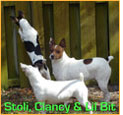 Shannon says "Pixie is soooooo sweet! She makes me smile every time I look at her. Pixie mothers all the other dogs, and even the cat. She cleans their ears and is very sweet when they cough or do that reverse sneeze thing. Pixie gets very concerned if she thinks they're hurt or not feeling well. She arrived very clean, with no fleas and not skittish at all."
Shannon says "Pixie is soooooo sweet! She makes me smile every time I look at her. Pixie mothers all the other dogs, and even the cat. She cleans their ears and is very sweet when they cough or do that reverse sneeze thing. Pixie gets very concerned if she thinks they're hurt or not feeling well. She arrived very clean, with no fleas and not skittish at all."
Pixie loves people, especially Shannon's boyfriend, and cuddles with him on his lap. Shannon loves Pixie, and says that she has fit into her home perfectly; she has actually considered adopting a fourth Ratbone dog!

Ratbone Rescues saves Rat Terriers in need. We foster them in our homes, train them, get them vet care then pass them on to their forever family when they are adopted, but this is not the end of what Ratbone does for the dogs we rescue.
- Tag with the rescue's 1-800 phone number.... $ 6.00
- Monthly charge to maintain 1-800 number.....$25.00
- Microchip, bought, inserted and registered..... $22.00
- Being rescued from a kill shelter A SECOND TIME, after being identified by a microchip.... Priceless
 The microchip is a tiny transponder - the size of a grain of uncooked rice. The chip, antenna, and capacitor are encased in a tiny glass tube. The tube is composed of soda lime glass, which is known for compatibility with living tissue. The glass is hermetically sealed to keep moisture out. The chip identification number is stored in the transponder, and can be read through the dog's skin by a scanner emitting low-frequency radio waves. The frequency is picked up by a tiny antenna in the transponder, and the number is retrieved, decoded, and displayed in the scanner readout window. The radio waves use a frequency much lower than AM broadcast stations use.
The microchip is a tiny transponder - the size of a grain of uncooked rice. The chip, antenna, and capacitor are encased in a tiny glass tube. The tube is composed of soda lime glass, which is known for compatibility with living tissue. The glass is hermetically sealed to keep moisture out. The chip identification number is stored in the transponder, and can be read through the dog's skin by a scanner emitting low-frequency radio waves. The frequency is picked up by a tiny antenna in the transponder, and the number is retrieved, decoded, and displayed in the scanner readout window. The radio waves use a frequency much lower than AM broadcast stations use.
The Story of Horatio
Horatio was a "teenage" Decker Rat Terrier when he was first rescued from a Texas kill shelter. He was fostered in north Texas and adopted to a Texas family in March of 2007, at about 10 months of age. Our follow-up phone call to his new family went well, so we were shocked when the shelter in Austin (Texas) contacted us early in November, 2009, saying they had one of our dogs.
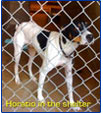 Thank goodness for Horatio's microchip, because his adopters had removed the Ratbone identification tag (with our toll free phone number) from his collar, then turned him in to the shelter. When the shelter scanned Horatio for a microchip and called the 24Petwatch registry, they were given our contact information, and one of our volunteers was called right away.
Thank goodness for Horatio's microchip, because his adopters had removed the Ratbone identification tag (with our toll free phone number) from his collar, then turned him in to the shelter. When the shelter scanned Horatio for a microchip and called the 24Petwatch registry, they were given our contact information, and one of our volunteers was called right away.
Without his microchip Horatio would have been put to death at the shelter, because he was an "owner surrender". These are the first dogs to be put to sleep in most shelters, when conditions are crowded. Shelters are required by law to hold a stray dog a certain number of days, but if the owners surrender their dog to the shelter they have no legal obligation to hold it. Horatio is a very lucky boy! He was reclaimed by Ratbone Rescues and is now safe and happy.
 If your dog isn't micro-chipped, please call your vet and talk about this life-saving tool. And remember to change your contact information with the microchip company any time you move or change phone numbers. It could be the difference between life and death for your canine companion.
If your dog isn't micro-chipped, please call your vet and talk about this life-saving tool. And remember to change your contact information with the microchip company any time you move or change phone numbers. It could be the difference between life and death for your canine companion.

Ratbone Rescues is a 501(c)(3) non-profit organization.
 To do this, follow the "Donate" button in the newsletter to the secure checkout page. Indicate the amount of your donation, for $5 you can create up to 2 greetings, $10, up to 5, then click "continue". In the box for description, note "Barker Heart" then the color followed by the message for each heart you wish to post.
To do this, follow the "Donate" button in the newsletter to the secure checkout page. Indicate the amount of your donation, for $5 you can create up to 2 greetings, $10, up to 5, then click "continue". In the box for description, note "Barker Heart" then the color followed by the message for each heart you wish to post. 





